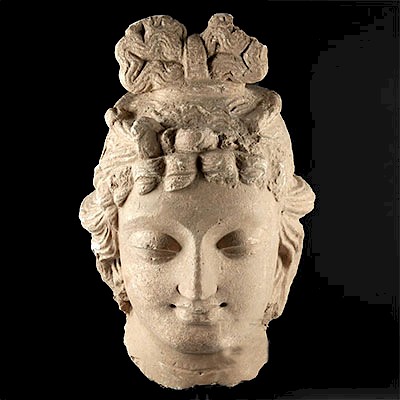Roman / Byzantine Glass Oil Lamp - Rare!
Lot 73
About Seller
Artemis Gallery
686 S Taylor Ave, Ste 106
Louisville, CO 80027
United States
Selling antiquities, ancient and ethnographic art online since 1993, Artemis Gallery specializes in Classical Antiquities (Egyptian, Greek, Roman, Near Eastern), Asian, Pre-Columbian, African / Tribal / Oceanographic art. Our extensive inventory includes pottery, stone, metal, wood, glass and textil...Read more
Estimate:
$2,800 - $4,200
Absentee vs Live bid
Two ways to bid:
- Leave a max absentee bid and the platform will bid on your behalf up to your maximum bid during the live auction.
- Bid live during the auction and your bids will be submitted real-time to the auctioneer.
Bid Increments
| Price | Bid Increment |
|---|---|
| $0 | $25 |
| $300 | $50 |
| $1,000 | $100 |
| $2,000 | $250 |
| $5,000 | $500 |
| $10,000 | $1,000 |
| $20,000 | $2,500 |
| $50,000 | $5,000 |
| $100,000 | $10,000 |
| $200,000 | $20,000 |
About Auction
By Artemis Gallery
Aug 30, 2018
Set Reminder
2018-08-30 10:00:00
2018-08-30 10:00:00
America/New_York
Bidsquare
Bidsquare : Fine Antiquities / Asian / Ethnographic Art
https://www.bidsquare.com/auctions/artemis-gallery/fine-antiquities-asian-ethnographic-art-3402
Featuring classical antiquities, Asian, ancient and ethnographic art from cultures encompassing the globe, plus fine art. Artemis Gallery info@artemisgallery.com
Featuring classical antiquities, Asian, ancient and ethnographic art from cultures encompassing the globe, plus fine art. Artemis Gallery info@artemisgallery.com
- Lot Description
Late Roman to Early Byzantine, ca. 2nd to 4th century CE. A conical mold-blown glass form with a rounded bottom, a wide mouth, and a flat rim, all boasting beautiful amber hues with liberal areas of weathering film and iridescence, the surface adorned with three wheel-cut bands around its body. Archaeologists have discovered such forms in ancient tombs. Some historians believe that they were used as lamps for the deceased to carry with them to the next world. A quote from Prudentius poetically describes such lamps in actual use (see extended description below). Contributing to its beauty are gorgeous areas of coppery rose, periwinkle blue, lavendar, and rainbow iridescence - as well as earthen deposits resulting from thousands of years of graceful aging and exposure to the elements. Size: 4.5" in diameter x 3.625" H (11.4 cm x 9.2 cm)
This type of vessel was used in the late Roman to early Byzantine periods, designed to be filled with oil and placed into large metal fixtures. These fixtures contained multiple lamps and provided illumination in the same way that a candelabrum does today. The following eloquent quote from Prudentius captures the magical quality of a lamp like this example, "As for us, we pass the long night with pious gladness in festal congregations, in sleepless prayer we earnestly heap up petitions that will be granted, and on the altar raised up make offerings to God. The lamps gleam out, that hang by swaying cords from every panel of the roof, and the flame, fed by the oil on which it floats lazily, casts its light through clear glass. One would think the starry space stood over us, decked with the twin Bears, and that bright evening stars were everywhere scattered, where the Wain directs its team of oxen. How worthy a thing, O God, for Thy flock to offer Thee at dewy night's beginning - light, Thy most precious gift, light, by which we perceive all Thy other blessings." (Prudentius, Cathemarina V. 137-152 - from Fortuna Fine Arts, Ltd. Catalogue entitled "Solid Liquid: Greek, Roman, Byzantine and Islamic Glass" (New York: 1999), p. 110. Also see similar examples of conical lamps in this publication - figures 199 and 200, pages 110-111).
Provenance: private East Coast, USA collection
All items legal to buy/sell under U.S. Statute covering cultural patrimony Code 2600, CHAPTER 14, and are guaranteed to be as described or your money back.
A Certificate of Authenticity will accompany all winning bids.
We ship worldwide and handle all shipping in-house for your convenience.
#135435Pontil scar on the bottom. Earthen deposits, weathering film, and beautiful iridescence on the surface. Old collection label on interior rim.Condition
- Shipping Info
-
All shipping is handled in-house for your convenience. Your invoice from Artemis Gallery will include shipping calculation instructions. If in doubt, please inquire BEFORE bidding for estimated shipping costs for individual items.
-
- Buyer's Premium



 EUR
EUR CAD
CAD AUD
AUD GBP
GBP MXN
MXN HKD
HKD CNY
CNY MYR
MYR SEK
SEK SGD
SGD CHF
CHF THB
THB
















